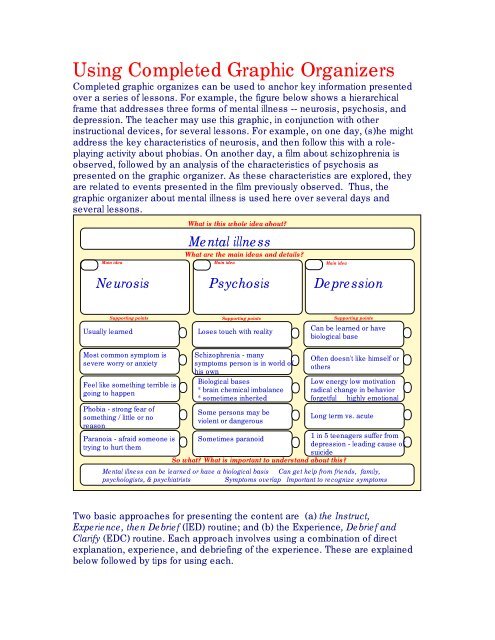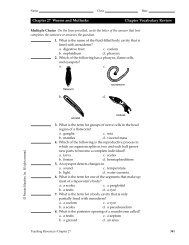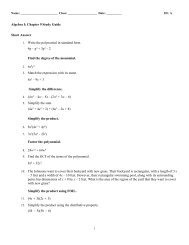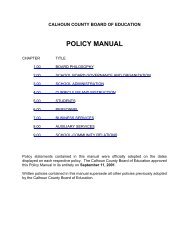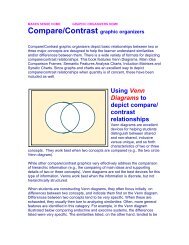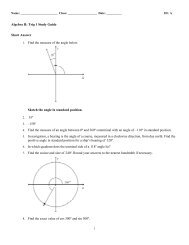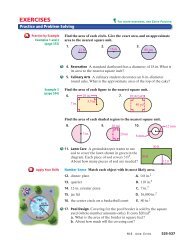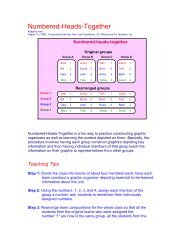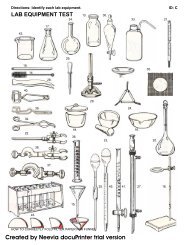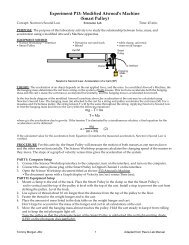Using Completed Graphic Organizers
Using Completed Graphic Organizers
Using Completed Graphic Organizers
Create successful ePaper yourself
Turn your PDF publications into a flip-book with our unique Google optimized e-Paper software.
<strong>Using</strong> <strong>Completed</strong> <strong>Graphic</strong> <strong>Organizers</strong><br />
<strong>Completed</strong> graphic organizes can be used to anchor key information presented<br />
over a series of lessons. For example, the figure below shows a hierarchical<br />
frame that addresses three forms of mental illness -- neurosis, psychosis, and<br />
depression. The teacher may use this graphic, in conjunction with other<br />
instructional devices, for several lessons. For example, on one day, (s)he might<br />
address the key characteristics of neurosis, and then follow this with a roleplaying<br />
activity about phobias. On another day, a film about schizophrenia is<br />
observed, followed by an analysis of the characteristics of psychosis as<br />
presented on the graphic organizer. As these characteristics are explored, they<br />
are related to events presented in the film previously observed. Thus, the<br />
graphic organizer about mental illness is used here over several days and<br />
several lessons.<br />
Main idea<br />
What is this whole idea about?<br />
Mental illness<br />
What are the main ideas and details?<br />
Main idea<br />
Main idea<br />
Neurosis Psychosis Depression<br />
Supporting points<br />
Usually learned<br />
Supporting points<br />
Loses touch with reality<br />
Supporting points<br />
Can be learned or have<br />
biological base<br />
Most common symptom is<br />
severe worry or anxiety<br />
Feel like something terrible is<br />
going to happen<br />
Phobia - strong fear of<br />
something / little or no<br />
reason<br />
Paranoia - afraid someone is<br />
trying to hurt them<br />
Schizophrenia - many<br />
symptoms person is in world of<br />
his own<br />
Biological bases<br />
* brain chemical imbalance<br />
* sometimes inherited<br />
Some persons may be<br />
violent or dangerous<br />
Sometimes paranoid<br />
suicide<br />
So what? What is important to understand about this?<br />
Often doesn't like himself or<br />
others<br />
Low energy low motivation<br />
radical change in behavior<br />
forgetful highly emotional<br />
Long term vs. acute<br />
1 in 5 teenagers suffer from<br />
depression - leading cause of<br />
Mental illness can be learned or have a biological basis Can get help from friends, family,<br />
psychologists, & psychiatrists Symptoms overlap Important to recognize symptoms<br />
Two basic approaches for presenting the content are (a) the Instruct,<br />
Experience, then Debrief (IED) routine; and (b) the Experience, Debrief and<br />
Clarify (EDC) routine. Each approach involves using a combination of direct<br />
explanation, experience, and debriefing of the experience. These are explained<br />
below followed by tips for using each.
The Instruct, Experience, then Debrief (EED) routine<br />
Consider teaching the information on the graphic organizer about mental illness<br />
illustrated in the above figure. In IED, the teacher would first provide students<br />
with a copy of the completed graphic organizer, and then explain the information<br />
on it (Instruct); next, a film about a teenager experiencing psychosis might be<br />
viewed by the class (Experience); finally, the teacher would help students make<br />
connections between the key information previously addressed on the graphic<br />
with the ideas presented in the film (Debrief.).<br />
See sample lesson social studies lesson plan think sheet<br />
The Experience, Debrief and Clarify (EDC) routine<br />
In EDC, similar tactics are used, but in a different order. For example, the film<br />
about psychosis might first be viewed (Experience), followed by a teacherfacilitated<br />
discussion about what they observed in the film (Debrief); then the<br />
students’ knowledge would be clarified and extended by providing them with the<br />
graphic organizer about mental illness and explaining the information on it,<br />
linking key concepts presented on the graphic to the ideas encountered during<br />
the experience of the film.<br />
See sample lesson science lesson plan think sheet<br />
Teaching Tips<br />
Explain, Experience, then Debrief (EED)<br />
Step 1: Provide an advance organizer<br />
* Introduce the lesson topic.<br />
* Provide a “hook” to gain students’ interest; you could choose from<br />
many of the Think Ahead activities provided.<br />
* Activate students’ background knowledge of related information.<br />
* In relation to the overall unit of study, review where the class has<br />
been, where it currently is, and where it is headed in the future.<br />
Step 2: Explain the information on the graphic organizer<br />
• Introduce the main-ideas of the lesson<br />
• Explain, discuss and ask questions about pertinent details related to<br />
each main-idea.<br />
• As you present the information on the graphic, facilitate quality<br />
interactions with and among students to increase student elaboration<br />
of the subject matter.<br />
Suggestion: When “walking students through” the pertinent information<br />
on the graphic organizer, use an overhead projector and transparency of
the graphic. You can use a piece of paper and sticky notes to cover up<br />
everything but the key points on which you want students’ attention to be<br />
focused. As you move on to the next point, you can shift the paper or<br />
remove the sticky note that was covering it. For example, the figure below<br />
shows how a teacher might use sticky notes and a piece of paper to<br />
cover all but the key points being addressed about neurosis.<br />
Main idea<br />
What is this whole idea about?<br />
Mental illness<br />
What are the main ideas and details?<br />
Main idea<br />
Main idea<br />
Neurosis Psychosis Depression<br />
Supporting points<br />
Usually learned<br />
Supporting points<br />
Loses touch with reality<br />
Supporting points<br />
Can be learned or have<br />
biological base<br />
Most common symptom is<br />
severe worry or anxiety<br />
Feel like something terrible is<br />
going to happen<br />
Phobia - strong fear of<br />
something / little or no<br />
reason<br />
Paranoia - afraid someone is<br />
trying to hurt them<br />
Schizophrenia - many<br />
symptoms person is in world of<br />
his own<br />
Biological bases<br />
* brain chemical imbalance<br />
* sometimes inherited<br />
Some persons may be<br />
violent or dangerous<br />
Sometimes paranoid<br />
suicide<br />
So what? What is important to understand about this?<br />
Often doesn't like himself or<br />
others<br />
Low energy low motivation<br />
radical change in behavior<br />
forgetful highly emotional<br />
Long term vs. acute<br />
1 in 5 teenagers suffer from<br />
depression - leading cause of<br />
Mental illness can be learned or have a biological basis Can get help from friends, family,<br />
psychologists, & psychiatrists Symptoms overlap Important to recognize symptoms<br />
Step 3: Provide the observation/hands-on activity.<br />
(e.g., watch a film, create a web, interview people, listen to original text,<br />
analyze pictures, etc.).<br />
Step 4: Either during or after the experience, debrief students and facilitate<br />
reflection.<br />
For example, you can ask questions that help students make<br />
connections to key ideas presented earlier.<br />
Samples of general, open-ended questions<br />
What connections can you make between this experience<br />
and the information on your graphic organizer?
In what ways does the information on your graphic organizer<br />
“show up” in this experience?<br />
Samples of questions targeted at specific ideas<br />
How does the way Jon acted in the film illustrate paranoia?<br />
Considering the way Jon acted in the film, was his symptoms<br />
more consistent with neurosis or psychosis? Why do you<br />
think so?<br />
Make explicit connections for students.<br />
For example...“Think about the way Jon behaved when he<br />
started acting so bizarre at the party during the film. Did you<br />
notice how he really thought everybody was talking about<br />
him and how upset and scared he got? That’s a classic<br />
symptom of paranoia. While everyone feels a little paranoid<br />
at times, the degree to which you saw Jon act paranoid<br />
suggests that he might be experiencing a form of psychosis.<br />
What other evidence did you see that suggested Jon might<br />
be psychotic?”<br />
Teaching Tips<br />
Experience, Debrief and Clarify (EDC)<br />
Step 1: Provide an advance organizer<br />
* Introduce the lesson topic.<br />
* Provide a “hook” to gain students’ interest. See Think Ahead activities<br />
for ideas..<br />
* Activate students’ background knowledge of related information.<br />
* In relation to the overall unit of study, review where the class has been,<br />
where it currently is, and where it is headed in the future.<br />
Step 2: Experience<br />
a. “Set-up” parameters for the observation experience<br />
* Introduce the observation experience.<br />
* Alert students to what they should observe during the experience.<br />
For example...<br />
“In a minute, we are going to watch a film about a teenager<br />
named Jon who may be experiencing mental illness. Watch<br />
for clues that indicate that he may be having problems. Note<br />
specific behaviors you observe that suggest to you that he<br />
might be mentally ill.“
. Complete the observation experience<br />
* Periodically, remind students about what they should be observing<br />
during the experience<br />
Step 3: Debrief<br />
a. ask general, open-ended questions<br />
* Cue students to share their observations<br />
* As appropriate, note key observations that students make on the<br />
board<br />
b. ask questions targeted at specific ideas.<br />
* Cue students to share their observations about specific observations<br />
Step 4: Clarify<br />
* Introduce the main-ideas presented on the graphic organizer.<br />
* Explain, discuss and ask questions about pertinent details related to<br />
each main-idea.<br />
* Facilitate student reflection.<br />
Step 5: Reflect<br />
* Provide an activity that promotes reflection on the core idea. See Think<br />
Back activities for ideas.<br />
INSTRUCTIONAL ROUTINES MENUE


